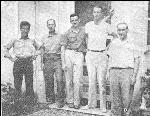COLUMBIA, Mo.—Since 1947, summer camp at the University Forest in Butler County has been a rite of passage for University of Missouri forestry students, who crammed a semester’s worth of class work coupled with real-world experience into just a few weeks.
On Oct. 7, more than a dozen forestry alumni along with active and retired MU forestry faculty and staff gathered at the University Forest Environmental Education Center to share memories and mark the closing of the 160-acre teaching and research center.
In recent years, revenue from outside groups using the University Forest for meetings, workshops and seminars hasn’t covered the growing costs of maintaining the 64-year-old facility, which includes cabins, a classroom/meeting center and a dining hall.
The University Forest is still in demand in the spring and summer. “But it sits empty for the rest of the year,” said David Larsen, MU forestry professor.
Some of MU’s other outstate research centers generate revenue by selling crops or livestock. However, with only 160 acres, the University Forest has limited opportunities to earn money from timber sales, Larsen said.
The University Forest occupies an ecological crossroads at the southeast edge of the Missouri Ozarks, where the vast upland forests of oak, hickory and pine start to give way to the river delta country of the Bootheel, where rich alluvial soils support the remnants of gigantic bottomland hardwoods and bald cypress.
This location provided students with the opportunity for hands-on learning within a variety of forest types and ecosystems, said Rose-Marie Muzika, chair of the MU Department of Forestry.
The phrase “summer camp” might suggest weeks of fun and recreation, and while there is some of that at MU forestry camp, alumni also recall doing a lot of hard work.
“We remember ticks, chiggers and the apparent mass confusion in which we accomplished our tasks,” wrote student Joe Garvey in a 1970s edition of a MU forestry student publication called The Missouri Log. “Looking back now one realizes how much was taught in that controlled confusion and how worthwhile that time was.”
“There’s a personal attachment for most students,” Muzika said. “Summer camp meant they were on the way to becoming professionals and could more accurately call themselves foresters.”
“I am sad to see the camp cease,” said Henry Deutsch, who earned MU bachelor’s and master’s degrees in forestry in the early 1960s. “I remember my time there as formative and vital. We have many good and bad memories, but overall they were progressive—not excluding the personal encounters with a rattlesnake, which we later ate.”
Among other things, students practiced their skills in identifying tree and plant species, studied forest ecology, forest management practices and wildlife habitat, and learned how to estimate the amount of merchantable timber in a given area.
Students would also swap whimsical tales of the “Karkhagne,” a mythical mischief-making beast said to lurk in the Ozarks.
With the property up for sale, the Karkhagne might be in for lonely times.
Meanwhile, the closure of the University Forest doesn’t mean the end of forestry summer camp.
“We’re dedicated to field education,” Muzika said.
Plans for 2012 and beyond are still forming, but some lessons and exercises can be done in the Columbia area at such places as MU’s 2,266-acre Baskett Research and Education Area near Ashland. Local activities may be supplemented by field trips to the Ozarks.
Read more http://extension.missouri.edu/news/DisplayStory.aspx?N=1264






